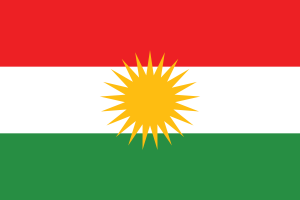Language/Central-kurdish/Grammar/How-to-Use-Be
Hi Central Kurdish learners! 😊
In this lesson, we will focus on the verb "Be" in Central Kurdish. This verb, which is used to describe existence, identity, relation, or possession, is very important to know and use correctly in any language. We will start by understanding its structure, and then we will move on to see various examples and exceptions. Let's get started!
Don't miss the chance to check out these pages as you wrap up this lesson: Common Conjunctions & Present Tense.
General Structure[edit | edit source]
The verb "Be" in Central Kurdish has a simple structure, consisting of three main parts. The first part is the subject, which can be either a pronoun or a noun. The second part is the verb stem, which is "Bû" for the present tense, and "Bûya" for the past tense. The third part is the ending, which changes according to the tense, mood, and voice.
Here is a table summarizing the endings:
| Tense | Mood | Voice | Ending |
|---|---|---|---|
| Present | Indicative | Active | am |
| Present | Indicative | Passive | in |
| Present | Negative | Active | nî |
| Present | Negative | Passive | nin |
| Past | Indicative | Active | bû |
| Past | Indicative | Passive | bûyî |
| Past | Negative | Active | nebû |
| Past | Negative | Passive | nebûyî |
Now, let's see some examples to understand how to use "Be".
Examples[edit | edit source]
Present Tense[edit | edit source]
In the present tense, "Be" is used to indicate existence or identity. Here are some examples:
- Min am. (I am.)
- Tu amî. (You are.)
- Ew ame. (He/She/It is.)
- Em amên. (We are.)
- Hûn amîn. (You all are.)
- Ew am in. (They are.)
In the present tense, "Be" is also used to indicate possession, with the help of a preposition. Here are some examples:
- Min te am. (I have you.)
- Tu min amî. (You have me.)
- Ew karekî ame. (He/She/It has a job.)
- Em kelîkê amên. (We have a car.)
- Hûn malên xwe amîn. (You all have your own houses.)
- Ew pirtukên xwe am in. (They have their own books.)
In the present tense, "Be" is used to ask questions as well. Here are some examples:
- Tu kî amî? (Who are you?)
- Ew çi ye? (What is it?)
- Hûn kelîkên xwe amîn? (Do you all have your own cars?)
In the present tense, negative sentences are formed by inserting "Nî" before the verb stem. Here are some examples:
- Min nîjam. (I am not.)
- Tu nî amî. (You are not.)
- Ew nîne. (He/She/It is not.)
- Em nî amên. (We are not.)
- Hûn nîn. (You all are not.)
- Ew nîn in. (They are not.)
In the present tense, negative sentences are also used to indicate absence or non-existence. Here are some examples:
- Nîshtimêj nîne. (There is no electricity.)
- Çavekî nîye. (There is no watermelon.)
- Hûn hezkirinên xwe nîn dikin. (You all don't have your own preferences.)
Past Tense[edit | edit source]
In the past tense, "Be" is used to indicate an action or state that occurred in the past. Here are some examples:
- Ez bûm. (I was.)
- Tu bûyî. (You were.)
- Ew bû. (He/She/It was.)
- Em bûn. (We were.)
- Hûn bûn. (You all were.)
- Ew bûyîn. (They were.)
In the past tense, negative sentences are formed by inserting "Nebû" before the verb stem. Here are some examples:
- Ez nebûm. (I was not.)
- Tu nebûyî. (You were not.)
- Ew nebû. (He/She/It was not.)
- Em nebûn. (We were not.)
- Hûn nebûn. (You all were not.)
- Ew nebûyîn. (They were not.)
In the past tense, negative sentences are also used to indicate the absence or non-existence of an action or state. Here are some examples:
- Niha tivînekî nebû. (There was no TV back then.)
- Bêxwedanek nebû. (There was no rebellion.)
- Hûn tundrewên xwe nebûn kir. (You all didn't make your own decisions.)
Dialogue[edit | edit source]
Person 1: Tu kîyî? (Who are you?)
Person 2: Ez Orkîdem. (I am Orkidem.)
Person 1: Tu karekî xwe heye? (Do you have a job?)
Person 2: Na, min karekî nîn heye. (No, I don't have a job.)
Person 1: Ez gelek xemgîn im. (I am very sad.)
Person 2: Ma tu xwestî xwe biçî bajarê? (Did you want to go to the city?)
Person 1: Bale, lê ez çû nîn me. (Yes, but I didn't go.)
(Person 1 and Person 2 continue to converse.)
Conclusion[edit | edit source]
Learning how to use "Be" is essential to improve your understanding and production of Central Kurdish sentences. You can use the examples and exceptions provided in this lesson to practice and enhance your skills. Remember, practice makes perfect! To improve your grammar and overall language abilities, you can also use the Polyglot Club website. Find native speakers and ask them any questions!
➡ If you have any questions, please ask them in the comments section below.
➡ Feel free to edit this wiki page if you think it can be improved. 😎
Great work on completing this lesson! Take a moment to investigate these connected pages: Possessive Pronouns & Common Prepositions.

